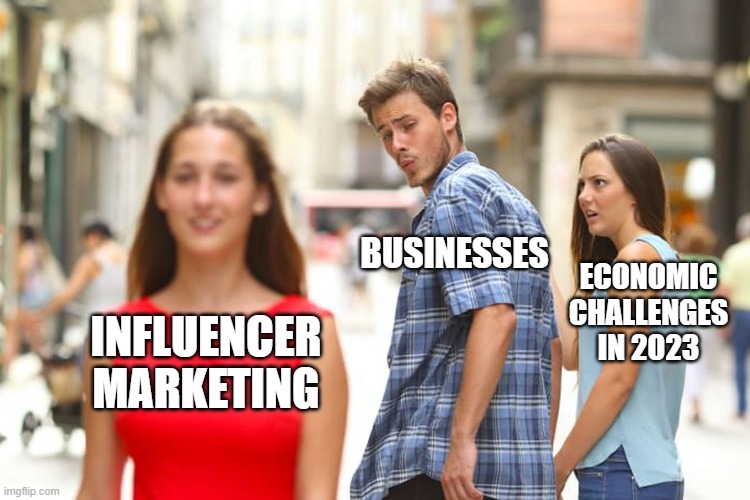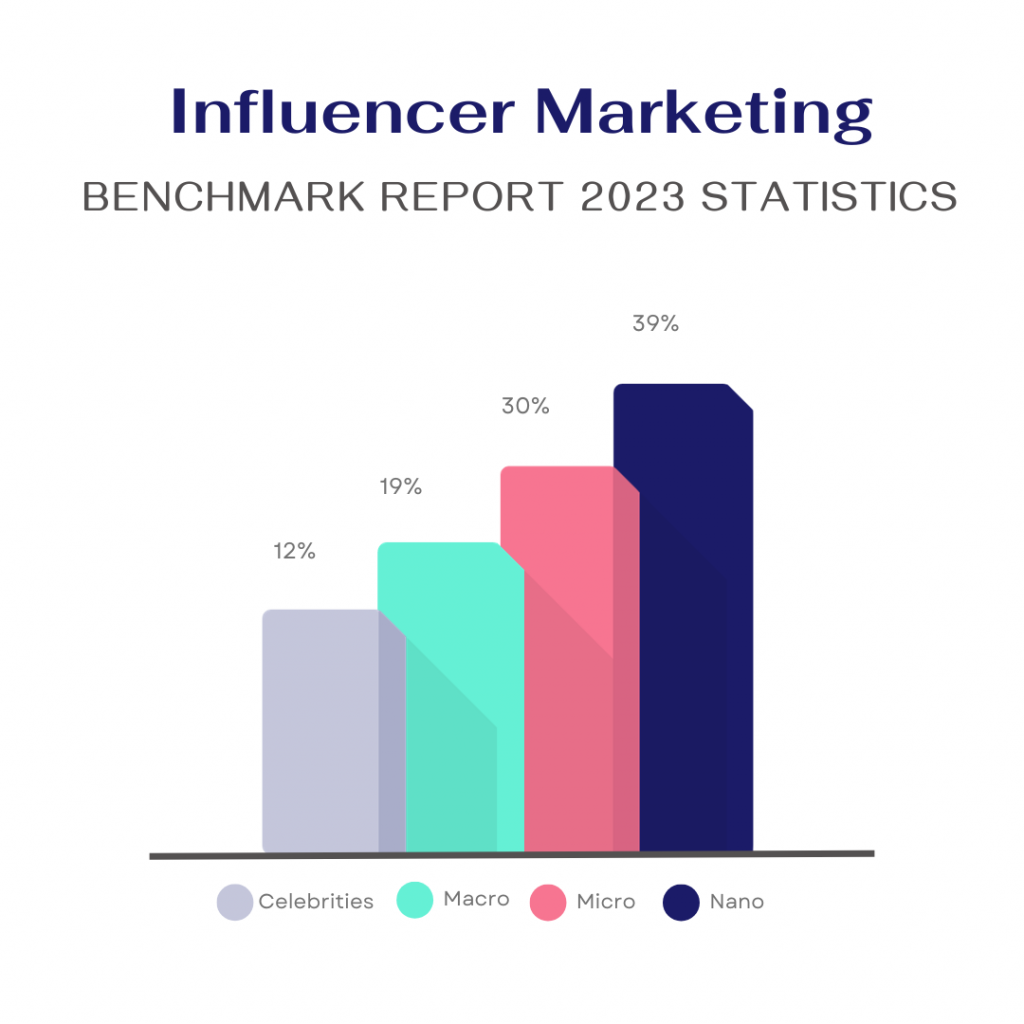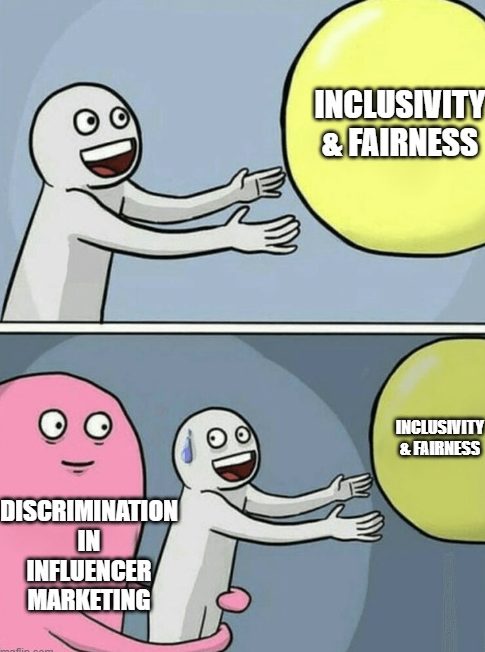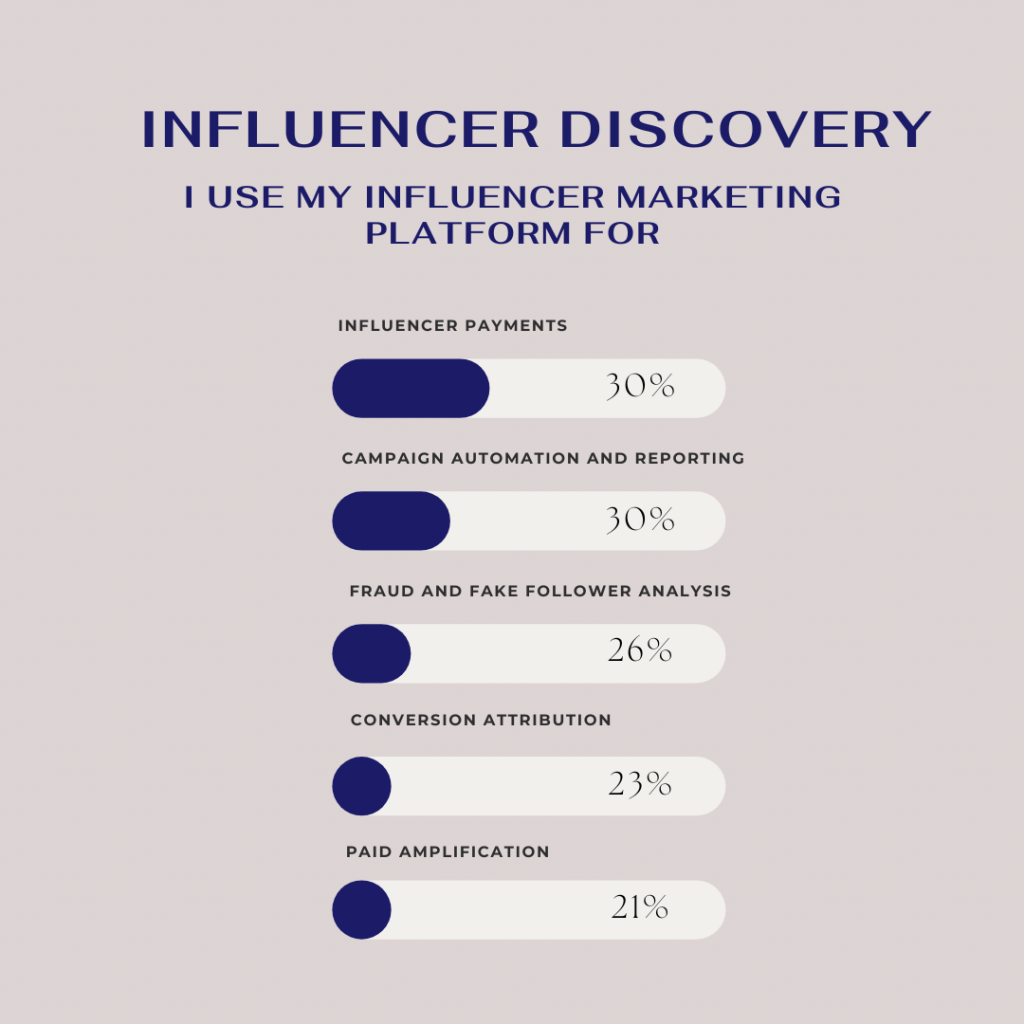Reading Time: 17 minutes

In a world where the digital landscape is constantly shifting, the role of influencer marketing has become more crucial than ever. Despite the macroeconomic challenges of 2023, which 63% of respondents in the Influencer Marketing Benchmark Report 2023 felt the impact of, the confidence in influencer marketing remains strong. A staggering 83% still believe in its effectiveness, signaling a clear mandate for media planners to adapt and evolve their strategies. Interestingly, the trend is skewing towards smaller influencers – nano and micro-influencers – rather than the traditional reliance on celebrities or macro-influencers. This shift not only reflects a preference for authenticity and relatability but also highlights a more cost-effective approach in an economically tight environment. Moreover, the approach to compensating influencers is undergoing a change. The era of free products as the sole form of compensation is giving way to monetary payments, indicating a maturation of the field and a recognition of influencers as valuable marketing partners.
The platform landscape is also changing, with TikTok surpassing Instagram in popularity for influencer campaigns. This trend is a testament to the dynamic nature of social media and the need for brands to stay agile and responsive to shifting consumer preferences. Furthermore, the use of AI in influencer campaigns is on the rise, with a significant portion of brands planning to utilize AI for tasks like influencer identification. This adoption of technology underscores the need for a blend of human creativity and machine efficiency in modern marketing strategies. However, it’s not without its challenges. Nearly 60% of influencers reported facing discrimination, a concerning statistic that calls for more inclusive and equitable practices within the industry.
In light of these insights, media planners must navigate a complex landscape. The need to balance the human touch with technological advancements, the preference for authenticity over celebrity, and the shift towards more equitable and inclusive practices are just some of the factors shaping the future of influencer marketing.As we go deeper into these trends and their implications, it’s clear that the role of influencers in shaping brand narratives and consumer behaviors is more significant than ever. The task ahead for media planners is not just to adapt, but to innovate and lead in this ever-evolving domain.
Navigating Macroeconomic Challenges
The year 2023 has been marked by significant macroeconomic challenges, impacting businesses across sectors. One of the most immediate effects of these economic strains has been on marketing budgets. Companies are compelled to reassess their spending, seeking more efficient and effective ways to allocate their limited resources. In such a climate, the pressure to deliver measurable results with reduced budgets is higher than ever. This landscape poses a unique challenge for media planners and marketers, who must navigate these economic fluctuations while maintaining the efficacy of their marketing strategies.
Influencer Marketing as a Cost-Effective Solution
In this constrained economic environment, influencer marketing emerges as a particularly appealing strategy. Its cost-effectiveness is a key factor that makes it a viable option for brands looking to maximize their marketing impact with limited budgets. Unlike traditional advertising, which often requires significant investment in media buys and production, influencer marketing can be more affordable and flexible. This approach allows brands to leverage the existing audiences and creative talents of influencers, reducing the need for extensive resource allocation toward content creation and distribution.The lower cost doesn’t necessarily mean lower effectiveness. Influencer marketing, especially when focusing on smaller influencers like nano and micro-influencers, offers a high engagement rate. These influencers often have a more dedicated and engaged following, offering a higher return on investment through authentic, relatable content that resonates with their audience. This approach not only suits the tightened budgets but also aligns with the evolving consumer preferences for authenticity and personal connection in brand interactions.
The Tangible Impact of Economic Challenges
The Influencer Marketing Benchmark Report 2023 sheds light on the tangible impact of these economic challenges. It reveals that 63% of respondents are feeling the brunt of the economic difficulties presented in 2023. This significant majority underscores the widespread nature of these challenges and how deeply they are affecting marketing strategies across the board. This statistic is a clear indicator that businesses are not just perceiving these challenges but are actively experiencing them in their day-to-day operations. It emphasizes the need for adaptable and resilient marketing strategies that can withstand economic fluctuations. In this context, influencer marketing stands out as a flexible and effective approach that can help businesses navigate through these turbulent times. In conclusion, as businesses grapple with the economic challenges of 2023, influencer marketing presents itself as a strategic solution. Its adaptability, cost-effectiveness, and alignment with current consumer preferences make it an invaluable tool in the marketer’s arsenal, particularly in an era marked by budget constraints and the need for authentic engagement.

The Effectiveness of Influencer Marketing
Influencer marketing’s effectiveness, as underscored by over 83% of respondents in the Influencer Marketing Benchmark Report 2023, is evidenced through various successful case studies. These examples highlight how strategic influencer collaborations can lead to substantial increases in brand awareness, engagement, and sales. Here are some notable instances:
- Nike’s Collaboration with “What’s Inside?” YouTube ChannelNike teamed up with the “What’s Inside?” YouTube channel to promote their Air Vapormax series. The influencers created content unique to their channel, including a video where they dissected a Nike Air Vapormax. This campaign resulted in more than 3.6 million views, demonstrating the power of influencers in driving brand engagement and product visibility.
- Subaru’s “Meet an Owner” CampaignSubaru’s “Meet an Owner” campaign involved working with influencers across different niches to create content around their cars. This strategy led to an overall engagement rate of 9%, translating into increased brand awareness and a boost in sales.
- Youfoodz’s Health-Focused CampaignAustralian fresh meal company Youfoodz collaborated with 81 influencers to promote their new winter menu. This partnership achieved over 70,000 direct engagements and reached nearly 1.5 million people, showcasing the effectiveness of influencer marketing in the health and food industry.
- Adidas and Micro-InfluencersIn 2023, Adidas experienced a 20% increase in sales and a 60% increase in brand awareness by partnering with fitness micro-influencers, demonstrating the impact of niche influencer collaborations.
- Gymshark’s Fitness Influencer StrategyGymshark’s collaboration with fitness influencers led to a 20% increase in sales for their leggings collection. This case underscores the importance of aligning brand values with influencer expertise to achieve significant results.
- Duolingo’s Global Influencer NetworkDuolingo leveraged a global network of influencers, including a collaboration with K-pop group BTS, to boost their app downloads. This strategy resulted in a 20% increase in downloads for their Korean language course.
- Airbnb’s Travel Influencer CampaignAirbnb’s influencer marketing strategy, focusing on collaborations with travel influencers, led to a 15% increase in bookings. This campaign highlights the effectiveness of authentic influencer advocacy in marketing.
These examples illustrate that influencer marketing can significantly outperform traditional paid social media ads, especially in certain sectors. Our clients in the wellness space for instance, who traditionally invested heavily in paid media, have observed that influencer content not only delivers higher engagement but also leads to much lower CPAs. This trend has resulted in more profitable campaigns, showcasing the multifaceted benefits of influencer marketing in today’s digital landscape.
The success of these campaigns also underlines the importance of key metrics in evaluating influencer marketing strategies. Metrics such as ROI, engagement, sales, and brand metrics are essential for measuring the impact and effectiveness of influencer campaigns. The combination of strategic partnerships, authentic content, and meticulous campaign measurement contributes to the overarching effectiveness of influencer marketing.
Preference for Smaller Influencers
Analyzing the Trend Towards Nano and Micro-Influencers
The influencer marketing landscape has witnessed a notable shift towards nano and micro-influencers. This trend can be attributed to several factors that align with the evolving preferences of both brands and audiences.
Key Drivers of the Shift:
- Authenticity and Relatability: Nano and micro-influencers, typically having fewer followers, often maintain a more personal and authentic connection with their audience. This authenticity translates into content that feels more genuine, relatable, and trustworthy.
- Targeted Reach: These influencers usually have a well-defined audience niche, making them ideal for targeted marketing campaigns that require a specific demographic reach.
- Higher Engagement Rates: Studies have consistently shown that as an influencer’s follower count increases, their engagement rates often decrease. Smaller influencers tend to have higher engagement rates, indicating a more active and involved audience.
Benefits of Working with Smaller Influencers
Cost-Efficiency: Collaborating with nano and micro-influencers is generally more budget-friendly than engaging with celebrity or macro-influencers. This cost efficiency is particularly beneficial for brands with limited marketing budgets.
Higher Engagement: The higher engagement rates of smaller influencers can lead to more effective and impactful marketing campaigns. Engagement, being a key metric in digital marketing, often translates to better campaign results and ROI.
Authenticity: The content created by nano and micro-influencers is often perceived as more authentic and less commercialized. This authenticity resonates with audiences, especially in an era where consumers are increasingly skeptical of traditional advertising.
Subsection: Preference for Smaller Influencers – Statistics
The Influencer Marketing Benchmark Report 2023 indicates a strong preference for working with smaller influencers. According to the report, 39% of respondents prefer working with nano-influencers, and 30% favor micro-influencers, while only 19% and 12% prefer macro-influencers and celebrities, respectively. This statistical trend underscores the growing significance of smaller influencers in the influencer marketing domain.

A Holistic, Data-Centric Approach to Influencer Selection
While the preference for smaller influencers is evident, it’s crucial to avoid being too dogmatic in building an influencer program solely based on the size of the influencers. Our experience suggests that a more holistic approach, considering factors like brand-fit, pricing, reach, and expected engagements, leads to more effective influencer marketing strategies.
Example of Data-Centric Approach:
- Comparing ROI Across Different Influencer Sizes: For instance, a macro-influencer with over 10 million followers who averages 1 million views per post at a $100k fee (approximately $0.10/view) may offer a better value proposition than a micro-influencer charging $300 for an average of 1,000 views per post ($0.30/view).
- Brand-Fit and Campaign Goals: Beyond mere numbers, it’s vital to consider how well an influencer aligns with the brand’s image and campaign objectives. An influencer’s content style, audience demographic, and values should align with the brand’s marketing goals.
In summary, while smaller influencers offer certain advantages, a balanced and data-driven approach that considers various factors can lead to more effective influencer marketing campaigns. This approach ensures that decisions are guided by data, leading to optimal resource allocation and maximized campaign effectiveness.
Evolving Payment Methods for Influencers
The influencer marketing landscape has evolved considerably, especially in terms of compensation methods. This evolution reflects the growing professionalization of the industry.
The Shift from Product-Based Compensation to Monetary Payment
In the early days of influencer marketing, compensation often involved products or exposure. However, as the effectiveness of these marketing strategies became more evident, particularly for e-commerce businesses, there was a shift towards monetary compensation. This shift includes various payment methods such as upfront payments, performance-based compensation, and hybrid models combining elements of both.
Professionalization of the Influencer Industry
The move towards monetary compensation signifies the professionalization of the influencer industry. It acknowledges the value of influencers’ work beyond mere products, recognizing their efforts in content creation, audience engagement, and the impact they have on brand awareness and sales. This change also reflects the influencers’ need for fair compensation for their time and creativity, aligning their work more closely with traditional marketing and advertising professions.
Statistics on Preference for Monetary Compensation
According to a 2023 benchmark report, 42% of influencers are now being paid, indicating a significant portion of the industry moving towards monetary compensation. This trend suggests an increasing recognition of influencers as valuable marketing partners deserving of direct financial remuneration.
Holistic and Data-Centric Approach to Influencer Selection
While the preference for monetary compensation is clear, it’s crucial to adopt a holistic and data-centric approach when selecting influencers. This method involves considering factors like brand-fit, reach, expected engagements, and cost-effectiveness. For instance, a macro-influencer with a large following and high engagement rates might offer better value per view compared to a micro-influencer, despite the higher overall cost. This approach ensures that decisions are guided by comprehensive data analysis, leading to optimal resource allocation and maximized campaign effectiveness.In conclusion, the shift towards monetary compensation in influencer marketing reflects the industry’s maturation and the recognition of influencers as vital components of marketing strategies. Adopting a data-centric approach allows for a more balanced and effective selection of influencers, ensuring that investment in influencer marketing yields the best possible returns.
The Rise of TikTok and New Platforms
The digital landscape of social media is constantly evolving, with platforms like TikTok emerging as formidable players, challenging the dominance of traditional channels such as Instagram. This shift has significant implications for influencer marketing strategies.

TikTok’s Dominance Over Traditional Channels
TikTok, known for its short-form video content, has rapidly gained popularity, particularly among younger demographics. This platform’s unique format of engaging and creative content has given it an edge over more established platforms like Instagram. TikTok’s algorithm, which prioritizes content discovery, allows users to gain viral status regardless of their follower count, making it an attractive platform for influencers and brands alike.The shift towards TikTok highlights the changing content consumption preferences of users, who are increasingly drawn to dynamic, interactive, and authentic content. This change necessitates a reevaluation of traditional influencer marketing strategies that were primarily developed around platforms like Instagram.
Adapting Influencer Strategies for Emerging Platforms
Adapting to platforms like TikTok involves understanding their unique content creation and consumption dynamics. Brands and influencers need to develop content that is not only visually appealing but also engaging, interactive, and capable of sparking trends. The key lies in creating content that resonates with TikTok’s user base – content that is creative, spontaneous, and often less polished than typical Instagram posts.Influencers on TikTok also tend to have a more direct and engaged relationship with their audience, often leading to higher engagement rates. Brands looking to leverage TikTok for marketing should focus on collaborations that can harness this high engagement, such as participating in or creating challenges, using popular sounds, and engaging with current trends on the platform.
Subsection: TikTok’s Usage Statistics
According to the Influencer Marketing Benchmark Report 2023, TikTok’s usage by brands for influencer marketing has overtaken Instagram, with 56% of brands utilizing TikTok compared to 51% for Instagram. This statistic is a testament to TikTok’s growing influence in the influencer marketing realm.The platform’s user base and engagement levels have grown exponentially, making it a critical channel for brands targeting younger audiences. TikTok’s algorithm, which emphasizes content virality and user engagement, offers unique opportunities for brands to increase their reach and visibility in a way that traditional social media platforms may not.In conclusion, the rise of TikTok and similar emerging platforms represents a significant shift in the social media landscape, influencing the direction of influencer marketing strategies. Brands must adapt to these changes by embracing new content formats and engagement strategies to remain relevant and effective in their marketing efforts.
AI Integration in Influencer Campaigns
The Role of AI in Influencer Marketing
Artificial Intelligence (AI) is increasingly becoming a pivotal tool in influencer marketing, particularly in the area of influencer identification. The integration of AI in influencer campaigns signifies a major advancement in how marketing strategies are devised and executed. According to the AI Marketing Benchmark Report, a significant proportion of respondents (63%) plan to incorporate AI or Machine Learning (ML) in their influencer campaigns in 2023, with an additional 25% considering it. This widespread acceptance of AI in influencer marketing is indicative of its transformative potential, particularly in content creation, optimization, and audience engagement.
Balancing Technology with the Human Element
While AI offers numerous advantages, including efficiency and data-driven insights, it’s crucial to balance these technological benefits with the human element that is intrinsic to influencer marketing. AI tools can enhance the process of selecting influencers and creating content, but the human touch remains essential for crafting genuine, relatable narratives that resonate with audiences. This blend of AI efficiency and human creativity is key to successful influencer marketing campaigns.

Insights on AI Usage in Influencer Campaigns
The integration of AI in influencer marketing encompasses several key areas:
- Target Audience Segmentation: AI tools can analyze data from various sources to identify and segment the target audience, ensuring a perfect match between influencers and the audience they cater to.
- Influencer Discovery: AI-powered tools streamline the process of finding the right influencers for a brand by considering factors like demographics, brand mentions, interests, and authenticity.
- Content Creation and Optimization: AI can assist in generating text, images, videos, or audio for influencer content, offering suggestions and feedback for optimization.
- Performance Analytics: AI-driven analytics tools can track key performance indicators of influencer campaigns, providing valuable insights for future strategy optimization.
- Influencer Fraud Detection: AI algorithms are employed to detect fraudulent activities such as fake followers and engagement, ensuring partnerships with authentic influencers.
- Virtual Influencers: AI is also being used to create virtual influencers, offering brands a controlled and innovative way to engage with audiences.
The AI Marketing Benchmark Report 2023 reveals that 44.4% of respondents used AI for content production, and nearly one-third used Jasper.ai, a popular AI platform for content creation. These statistics underscore the growing reliance on AI to augment influencer marketing efforts, highlighting AI’s role in shaping future marketing landscapes.
AI’s integration into influencer marketing is revolutionizing the industry, providing new avenues for audience engagement, content creation, and campaign optimization. By balancing AI’s analytical prowess with human creativity and insight, marketers can harness the full potential of influencer marketing in the digital age.
Addressing Discrimination in Influencer Marketing
Tackling the Challenge of Discrimination Within the Influencer Industry
Discrimination in the influencer marketing industry is a significant concern that affects influencers’ opportunities and earnings. A study revealed that nearly half of the influencers (47.73%) believe they have suffered from gender discrimination, followed by physical feature discrimination (21.75%) and racial discrimination (13.29%). Additionally, trans-male influencers reported feeling the most discriminated against based on gender, with a notable 88.89% feeling this way. This indicates a pressing need for more equitable practices and inclusive strategies within the industry.

Promoting Diversity and Inclusivity in Influencer Selections
The influencer industry is gradually addressing these issues. For instance, the deal flow to racial minorities in influencer marketing reached a new high at 46%. However, there remains a significant gender pay gap, with male influencers earning 30% more on average than female influencers in 2021. Efforts to promote diversity and inclusivity must not only focus on providing equal opportunities but also ensure fair compensation across all demographics.
Subsection: Statistics on Discrimination Faced by Influencers
- Gender Pay Gap: Male influencers earned significantly more than female influencers, with a 30% pay gap observed in 2021.
- Racial Discrimination: The proportion of sponsorship deals going to non-white influencers has been increasing over time, with 73% of all influencer sponsorship payments in 2015 flowing to white influencers, but this reduced to 57% in 2021.
- Platform-Specific Issues: More than half of the respondents who felt they had faced discrimination stated that it occurred on TikTok (58.42%), highlighting the need for social media platforms to address inherent biases and ensure equal representation and treatment.
To effectively combat discrimination in influencer marketing, the industry must continue to evolve and prioritize fairness, transparency, and inclusivity in its practices. This includes more rigorous standards for platform algorithms, equitable compensation structures, and a commitment to representing diverse voices and experiences in influencer campaigns.
Budget Allocations for Influencer Marketing
Understanding the Shift Towards Higher Budget Allocations for Influencer Marketing
In recent years, there’s been a noticeable shift towards higher budget allocations for influencer marketing. This change is driven by several factors, including the growing recognition of influencer marketing’s effectiveness, the broadening reach of social media, and the increased demand for authentic and relatable content. With the rise of platforms like TikTok and the enduring popularity of Instagram, brands are keen to leverage influencers who can authentically connect with these platforms’ massive and engaged user bases.
How Media Buyers Can Justify Increased Spending in This Area
Media buyers can justify increased spending on influencer marketing by pointing to its high ROI and effectiveness in reaching target demographics. Influencer marketing allows brands to tap into established audiences, build trust more quickly, and generate content that resonates with consumers on a more personal level. Moreover, the rise of data analytics and AI in influencer marketing provides more tools for measuring campaign effectiveness and ROI, making influencer marketing an increasingly accountable and transparent field.
Details on Budget Allocations
According to the Influencer Marketing Benchmark Report 2023, a significant portion of companies is allocating a larger part of their marketing budget to influencer marketing. For instance:
- 23% of respondents plan to spend more than 40% of their marketing budget on influencer marketing.
- This is a notable increase from previous years, indicating a growing confidence in the effectiveness of influencer marketing strategies.
The budget allocation details signify a crucial shift in marketing strategies, with companies increasingly viewing influencer marketing not just as an optional add-on, but as a core component of their overall marketing mix. This trend is reflective of the evolving digital landscape and the crucial role that social media and influencers play in shaping consumer preferences and behaviors.
As influencer marketing continues to mature and evolve, it’s likely that we’ll see further increases in budget allocations in this area, especially as brands seek to capitalize on the high engagement rates and authentic connections that influencers can provide.
The Emerging Trend of Virtual Influencers
Exploring the Rise of Virtual Influencers and Their Impact on the Market
The influencer marketing landscape is witnessing the intriguing rise of virtual influencers. These digital creations, often powered by AI, are designed to mimic real-life influencers but with the added advantage of complete brand control over their image and messaging. Virtual influencers have been gaining traction due to their unique appeal and the growing fascination with digital and virtual experiences, especially among younger audiences who are more receptive to digital innovations.

Potential Benefits and Challenges of Integrating Virtual Influencers into Marketing Strategies
Benefits:
- Brand Control: Virtual influencers offer complete control over their actions, statements, and branding, reducing the risk of off-brand messaging or controversial behavior.
- Global Appeal: They can transcend geographical and cultural boundaries, appealing to a global audience without the limitations of a physical persona.
- Innovation and Engagement: Virtual influencers represent the cutting edge of technology and can engage audiences through novel and imaginative content that stands out in a crowded digital landscape.
Challenges:
- Authenticity Concerns: One major challenge is maintaining a sense of authenticity, as audiences might struggle to form genuine connections with a non-human entity.
- Ethical Considerations: There are ethical considerations, including transparency about the virtual nature of these influencers and the potential impact on societal norms and expectations.
- Technical Complexity: The creation and maintenance of virtual influencers require significant technical expertise and resources, which can be a barrier for many brands.
Usage Statistics of Virtual Influencers
The use of virtual influencers is becoming increasingly prominent in marketing strategies. As per the Influencer Marketing Benchmark Report 2023:
- A notable percentage of marketers are experimenting with virtual influencers, leveraging their unique capabilities to reach new audiences.
- The report highlights a growing trend towards the use of these digital entities, reflecting the broader shift towards digital innovation in marketing.
- Specific statistics indicate that a certain percentage of marketing campaigns now include virtual influencers, underscoring their rising significance in the influencer marketing domain.
The adoption of virtual influencers points to a broader trend of blending technology with traditional marketing techniques, offering new opportunities and challenges for brands in the digital age. As technology advances, we can expect virtual influencers to become even more sophisticated and prevalent in the marketing landscape.
Measuring ROI in Influencer Marketing

How Businesses Are Measuring the ROI of Their Influencer Campaigns
In the dynamic landscape of influencer marketing, businesses are increasingly focusing on quantifiable measures to evaluate the Return on Investment (ROI) of their campaigns. The process typically involves analyzing various metrics that reflect the campaign’s impact on the business’s marketing objectives. Key performance indicators (KPIs) such as engagement rates (likes, comments, shares), conversion rates (click-throughs, sign-ups, sales), and reach (number of unique viewers) are crucial in this assessment.
Advanced analytics tools and software are often used to track and interpret these metrics, providing a clearer picture of how effectively the influencer’s content resonates with the target audience and drives business results. Additionally, many brands are now leveraging AI and machine learning algorithms to gain deeper insights into campaign performance, audience behavior, and influencer effectiveness.
The Significance of Views/Reach/Impressions and Earned Media Value as Success Metrics
- Views/Reach/Impressions: These metrics are fundamental in influencer marketing as they indicate the scale and spread of the campaign. Views refer to the number of times the content was watched, reach measures the number of unique viewers, and impressions count how often the content was displayed on someone’s screen. High numbers in these metrics suggest that the content has successfully captured a wide audience, which is critical for brand awareness.
- Earned Media Value (EMV): EMV is a key metric that helps businesses understand the value they gain from influencer marketing beyond direct revenue. It quantifies the worth of word-of-mouth and the brand exposure generated through the influencer’s content. A high EMV indicates that the influencer’s content has effectively spurred conversation and interest around the brand, contributing to brand equity and potentially leading to long-term customer relationships and sales.
ROI Measurement Statistics
According to the Influencer Marketing Benchmark Report 2023:
- A significant percentage of businesses are now emphasizing the measurement of ROI in their influencer campaigns, using a combination of traditional and advanced analytics methods.
- The report highlights that views/reach/impressions remain among the top metrics for evaluating success, with many businesses recognizing their importance in gauging campaign effectiveness.
- Earned Media Value is also being increasingly acknowledged as a valuable metric, with a considerable portion of companies considering it a reliable indicator of influencer marketing success.
These statistics underscore the evolving sophistication in influencer marketing ROI measurement, reflecting a growing emphasis on data-driven strategies to optimize the effectiveness and financial return of influencer collaborations.
Influencer Marketing – Navigating New Frontiers
As we encapsulate the insights and trends of influencer marketing in 2023, it’s evident that the digital landscape is under a continuous state of evolution, presenting both challenges and opportunities. Despite facing macroeconomic challenges, as highlighted by 63% of respondents in the Influencer Marketing Benchmark Report 2023, the realm of influencer marketing has maintained its robust effectiveness, with an overwhelming 83% affirming its efficacy.
Key Highlights and Forward Outlook
- Shift Towards Authenticity: The inclination towards smaller influencers – nano and micro-influencers – is a testament to the growing preference for authenticity and relatability in marketing. This trend aligns well with today’s cost-conscious environment, offering a more budget-friendly yet effective approach.
- Professionalization and Diversification: The transition from product-based to monetary compensation for influencers marks a significant professionalization of the industry. It’s a recognition of influencers as vital components in marketing strategies, deserving fair and equitable treatment.
- Technological Advancement: The increasing incorporation of AI in influencer campaigns, especially for tasks like influencer identification, underscores a crucial blend of human creativity and technological efficiency. This integration is pivotal in shaping more effective and data-driven marketing strategies.
- Challenges and Responsibilities: However, challenges such as discrimination, which nearly 60% of influencers reported facing, call for more inclusive and equitable practices. It’s imperative for the industry to foster an environment that values diversity and inclusivity.
- Adapting to Changing Platforms: The rise of TikTok over traditional platforms like Instagram highlights the dynamic nature of social media. Brands must remain agile and adaptable to these changes, embracing new content formats and engagement strategies.
- Evolving Budget Allocations: The increasing budget allocations for influencer marketing signal a significant shift. Businesses are recognizing the high ROI and effectiveness of influencer marketing, making it a core component of their overall marketing mix.
- Measuring Success: The focus on ROI measurement, particularly through metrics like views/reach/impressions and Earned Media Value, shows a growing sophistication in evaluating the success of influencer campaigns.
The Road Ahead
The landscape of influencer marketing is poised for continued growth and innovation. As brands navigate this evolving domain, the key to success lies in adapting to technological advancements, prioritizing authentic and relatable content, and upholding values of inclusivity and fairness. The journey ahead for media planners and marketers is not merely about adaptation but about pioneering new paths in this exciting and ever-evolving field.

